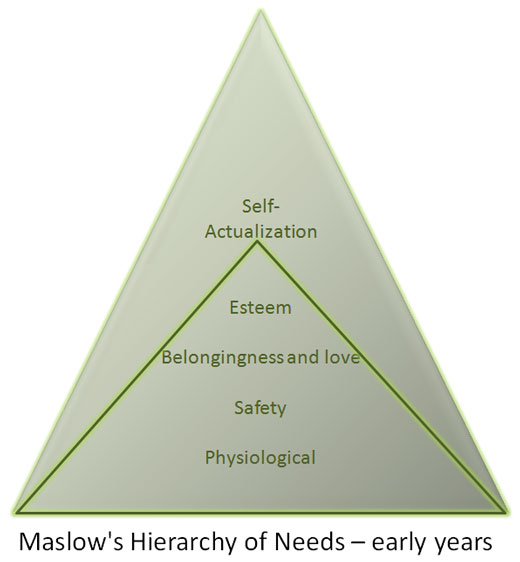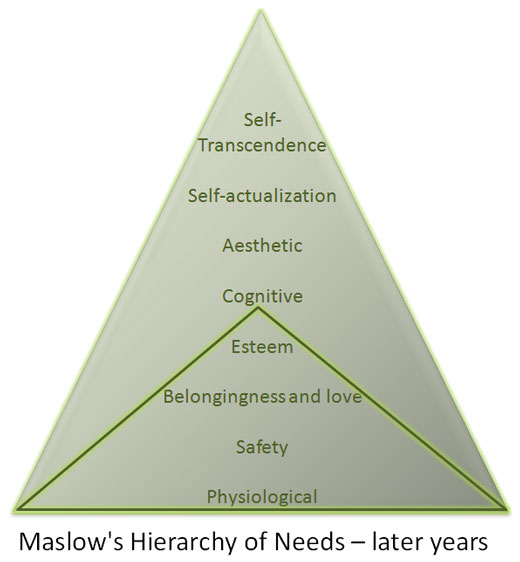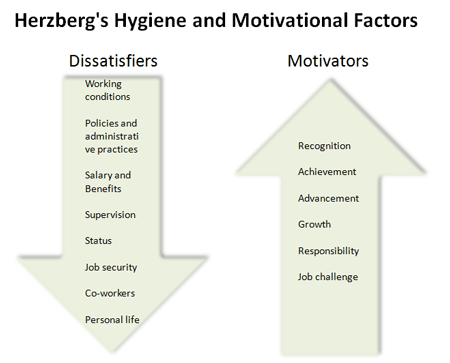Leadership and Human Behavior
We must become the change we want to see. - Mahatma Gandhi
As a leader, you need to interact with your followers, peers, seniors, and others; whose support you need in order to accomplish your goals. To gain their support, you must be able to understand and motivate them. To understand and motivate people, you must know human nature. Human nature is the common qualities of all human beings. People behave according to certain principles of human nature.
Human needs are an important part of human nature. Values, beliefs, and customs differ from country to country and even within group to group, but in general, all people have a few basic needs. As a leader, you must understand these needs because they can be powerful motivators.
Maslow's Hierarchy of Needs
Unlike others researchers of his time, Abraham Maslow's based his theory of human needs on creative people who used all their talents, potential, and capabilities (Bootzin, Loftus, Zajonc, Hall, 1983). His methodology differed from other psychological researchers who mostly observed mentally unhealthy people.
Maslow (1943) felt that human needs were arranged in a hierarchical order that could be divided into two major groups: basic needs and metaneeds (higher order needs):
- Basic Needs are physiological, such as food, water, and sleep; and psychological, such as affection, security, and self-esteem. These basic needs are also called “deficiency needs” because if an individual does not meet them, then that person will strive to make up the deficiency.
- Metaneeds or being needs (growth needs). These include justice, goodness, beauty, order, unity, etc. Basic needs normally take priority over these meta needs. For example, a person who lacks food or water will normally not attend to justice or beauty needs.
These needs are often listed in a hierarchical order in the form of a pyramid to show that the basic needs (bottom ones) must be met before the higher order needs. However, it should be pictured more as a box, see the section, Criticisms and Strengths, below for more information:

- Self-actualization — know exactly who you are, where you are going, and what you want to accomplish. A state of well-being
- Esteem — feeling of moving up in world, recognition, few doubts about self
- Belongingness and love — belong to a group, close friends to confide with
- Safety — feel free from immediate danger
- Physiological — food, water, shelter, sex
Note: Maslow later added three additional higher order needs to his theory.
Maslow posited that people want and are forever striving to meet various goals. Because the lower level needs are more immediate and urgent, then they come into play as the source and direction of a person's goal if they are not satisfied.
A need higher in the hierarchy will become a motive of behavior as long as the needs below it have been satisfied. Unsatisfied lower needs will normally dominate unsatisfied higher needs, thus they must normally be satisfied before the person can rise up in the hierarchy.
Knowing where a person is located on the pyramid will aid you in determining effective motivators. For example, motivating a middle-class person who has met the first four levels with positive feedback and encouragement will have a greater impact than using the same motivator to affect a minimum wage person from the ghetto who is desperately struggling to meet his or her basic needs.
It should be noted that almost no one stays in one particular hierarchy for an extended period. We constantly strive to move up, while at the same time various forces outside our control try to push us down. Those on top get pushed down for short time periods, e.g., death of a loved-one or an idea that does not work; while those on the bottom get pushed up, e.g., earn the education they need or come across a small reward or prize. Our goal as leaders therefore is to help people obtain the skills, knowledge, and benefits that will push them up the hierarchy. People who have their basic needs met become much better workers as they are able to concentrate on fulfilling their and the organization's visions, rather than consistently struggling to make ends meet.
Criticisms and Strengths
The above statements may be considered generalizations. Maslow's theory has often been criticized because we can find exceptions to it, such as the military, police, firefighters, etc. who will risk their safety for the well-being of others or parents who will sacrifice their basic needs for their children. However, there are very few theories about human nature that are not flawed once we start drilling down to the individualistic level. Even Newton's theory of physics, which became laws, fell apart once we were able to drill down to the atomic level.
A recent study (Tay, Diener, 2011) discovered that as hypothesized by Maslow, people tend to achieve basic and safety needs before other needs. However, fulfilling the various needs has relatively independent affects on a person's subjective well-being. Thus, rather than being a pyramid with the basic human needs arranged in a hierarchical order, it is more like a box with the basic human needs scattered within and depending on the situation and/or environment, different needs rise to the top to compensate for the deficient needs.
Maslow's theory remains a classic because rather than looking at psychology as strictly the study of the mentally ill, his theory was based upon mentally healthy people (known as humanistic psychology). And being one of the first humanistic ones, it has its share of flaws.
Expansion of the Pyramid
In Maslow's (1971) later years, he become more interested in the higher order or metaneeds and tried to further distinguish them. Maslow theorized that the ultimate goal of life is self-actualization, which is almost never fully attained, but rather is something we try to always strive for.
He later theorized that this level does not stop; it goes on to self-transcendence, which carries us to the spiritual level, e.g. Gandhi, Mother Theresa, Dalai Lama, or even poets, such as Robert Frost. Maslow's self-transcendence level recognizes the human need for ethics, creativity, compassion and spirituality. Without this spiritual or transegoic sense, we are simply become machines.
This expansion of the higher order needs is shown here:

Note that the four meta needs (above the inner pyramid) can be pursued in any order, depending upon a person's wants or circumstances, as long as the basic needs have all been met (the below chart is listed from top to bottom needs):
- Self-transcendence — a transegoic (see Note below) level that emphasizes visionary intuition, altruism, and unity consciousness.
- Self-actualization — know exactly who you are, where you are going, and what you want to accomplish. A state of well-being.
- Aesthetic — to do things not simply for the outcome but because it's the reason you are here on earth — at peace, more curious about the inner workings of all things.
- Cognitive — to be free of the good opinion of others — learning for learning alone, contribute knowledge.
- Esteem — feeling of moving up in world, recognition, few doubts about self.
- Belongingness and love — belong to a group, close friends to confide with.
- Safety — feel free from immediate danger.
- Physiological — food, water, shelter, sex.
Note: Transegoic means a higher, psychic, or spiritual state of development. The trans is related to transcendence, while the ego is based on Freud's work. We go from preEGOic levels to EGOic levels to transEGOic. The EGO in all three terms is used in the Jungian sense of consciousness as opposed to the unconscious. Ego equates with the personality.
In addition, just as in his earlier model, we may be in a state of flux — we shift between levels (Maslow, 1968). For example there may be peak experiences for temporary self-actualization and self-transcendence. These are our spiritual or creative moments.
Characteristics of Self-actualized People
People who have reached the state of self-actualization tend to display the following characteristics:
- have better perceptions of reality and are comfortable with it
- accept themselves and their own natures
- lack artificiality
- focus on problems outside themselves and are concerned with basic issues and eternal questions
- like privacy and tend to be detached
- rely on their own development and continued growth
- appreciate the basic pleasures of life (e.g. do not take blessings for granted)
- have a deep feeling of kinship with others
- are deeply democratic and are not really aware of differences
- have strong ethical and moral standards
- are original, inventive, less constricted and fresher than others
Going Beyond Maslow
While the research of Maslow's theory has undergone limited empirical scrutiny, it still remains quite popular due to its simplicity and being the start of the movement away from behaviorist, reductionistic, and mechanistic approaches to a more humanistic one.
In addition, a lot of concerns are directed at his methodology in that he picked a small number of people that he declared self-actualized and came to the conclusion about self-actualization. However, he understood this and thought of his work as simply a method of pointing the way, rather than being the final say. In addition, he hoped that others would take up the cause and complete what he had begun.
Other researchers have taken up his cause and further refined them, mostly in the area of organizations and work. Herzberg, Alderfer, and McGregor's research are all closely tied to Maslow's theory.
Herzberg's Hygiene and Motivational Factors
Frederick Herzberg was considered one of the most influential management consultants and professors of the modern postwar era. Herzberg was probably best known for his challenging thinking on work and motivation. He was considered both an icon and legend among visionaries such as Abraham Maslow, Peter Drucker, and Douglas McGregor.
Herzberg (1966) is best known for his list of factors that are based on Maslow's Hierarchy of Needs, except his version is more closely related to the working environment:
HERZBERG'S HYGIENE & MOTIVATIONAL FACTORS
Hygiene factors must be present in the job before motivators can be used to stimulate a person. That is, you cannot use motivators until all the hygiene factors are met. If the factor is not met, then it becomes a Dissatisfier. Herzberg's needs are specifically job related and reflect some of the distinct things that people want from their work, as opposed to Maslow's Hierarchy of Needs that reflect the needs in a person's life.
Hygiene or Dissatisfiers:
- Working conditions
- Policies and administrative practices
- Salary and Benefits
- Supervision
- Status
- Job security
- Co-workers
- Personal life
Motivators or Satisfiers:
- Recognition
- Achievement
- Advancement
- Growth
- Responsibility
- Job challenge

Hygiene or dissatisfiers factors must be present in the job before motivators can be used to stimulate a person. That is, you cannot use motivators until all the hygiene factors are met. Herzberg's needs are specifically job related and reflect some of the distinct things that people want from their work as opposed to Maslow's Hierarchy of Needs that reflect all the needs in a person's life.
Building on this model, Herzberg coined the term job enrichment — the process of redesigning work in order to build in motivators by increasing both the variety of tasks that an employee performs and the control over those tasks. It is associated with the design of jobs and is an extension of job enlargement (an increase in the number of tasks that an employee performs). Note the term Job Enlargement means that a variety of tasks are performed to reduce boredom, rather than overloading a person with too many tasks.
McGregor's Theory X and Theory Y
Douglas McGregor (1957) developed a philosophical view of humankind with his Theory X and Theory Y — two opposing perceptions about how people view human behavior at work and organizational life. McGregor felt that organizations and their managers followed one or the other approach:
Theory X
- People have an inherent dislike for work and will avoid it whenever possible.
- People must be coerced, controlled, directed, or threatened with punishment in order to get them to achieve the organizational objectives.
- People prefer to be directed, do not want responsibility, and have little or no ambition.
- People seek security above all else.
In an organization with Theory X assumptions, management's role is to coerce and control employees.
Theory Y
- Work is as natural as play and rest.
- People will exercise self-direction if they are committed to the objectives (they are NOT lazy).
- Commitment to objectives is a function of the rewards associated with their achievement.
- People learn to accept and seek responsibility.
- Creativity, ingenuity, and imagination are widely distributed among the population. People are capable of using these abilities to solve an organizational problem.
- People have potential.

In an organization with Theory Y assumptions, management's role is to develop the potential in employees and help them to release that potential towards common goals.
Theory X is the view that traditional management has taken towards the workforce. Most organizations are now taking the enlightened view of theory Y (even though they might not be very good at it). A boss can be viewed as taking the theory X approach, while a leader takes the theory Y approach.
Notice that Maslow, Herzberg, and McGregor's theories all tie together:
- Herzberg's theory is a micro version of Maslow's theory in that it is focused on the work environment.
- McGregor's Theory X is based on workers caught in the lower levels (1 to 3) of Maslow's theory due to bad management practices, while Theory Y is for workers who have gone above level 3 with the help of management.
- McGregor's Theory X is also based on workers caught in Herzberg's Hygiene Dissatisfiers, while Theory Y is based on workers who are in the Motivators or Satisfiers section.
Next Steps
Go to Page 2 of Leadership and Human Behavior (Alderfer and Vroom)
Go to the main Leadership Page
References
Alderfer, C. (1969). An Empirical Test of a New Theory of Human Needs. Organizational Behavior and Human Performance, vol. 4, pp. 14 -175.
Bootzin, R., Loftus, E., Zajonc, R., Hall, E. (1983). Psychology Today: An Introduction. New York: Random House. Fifth Edition.
Herzberg, F. (1966). Work and the Nature of Man. Cleveland: World Publishing Co.
Maslow, A.H. (1943). A Theory of Human Motivation. Psychological Review, 50, 370-396.
Maslow, A.H. (1968). Toward a Psychology of Being. (2nd ed.). New York: Van Nostrand Reinhold.
Maslow, A.H. (1971). The Farther Reaches of Human Nature. New York: McGraw-Hill.
McGregor, D.M. (1957). Proceedings of the Fifth Anniversary Convocation of the School of Industrial Management, The Human Side of Enterprise. Massachusetts Institute of Technology.
Tay, L., Diener, E. (2011). Needs and subjective well-being around the world. Journal of Personality and Social Psychology, Vol 101(2), Aug 2011, 354-365.
Vroom, V. (1964). Work and Motivation. New York: Jon Wiley & Sons.
